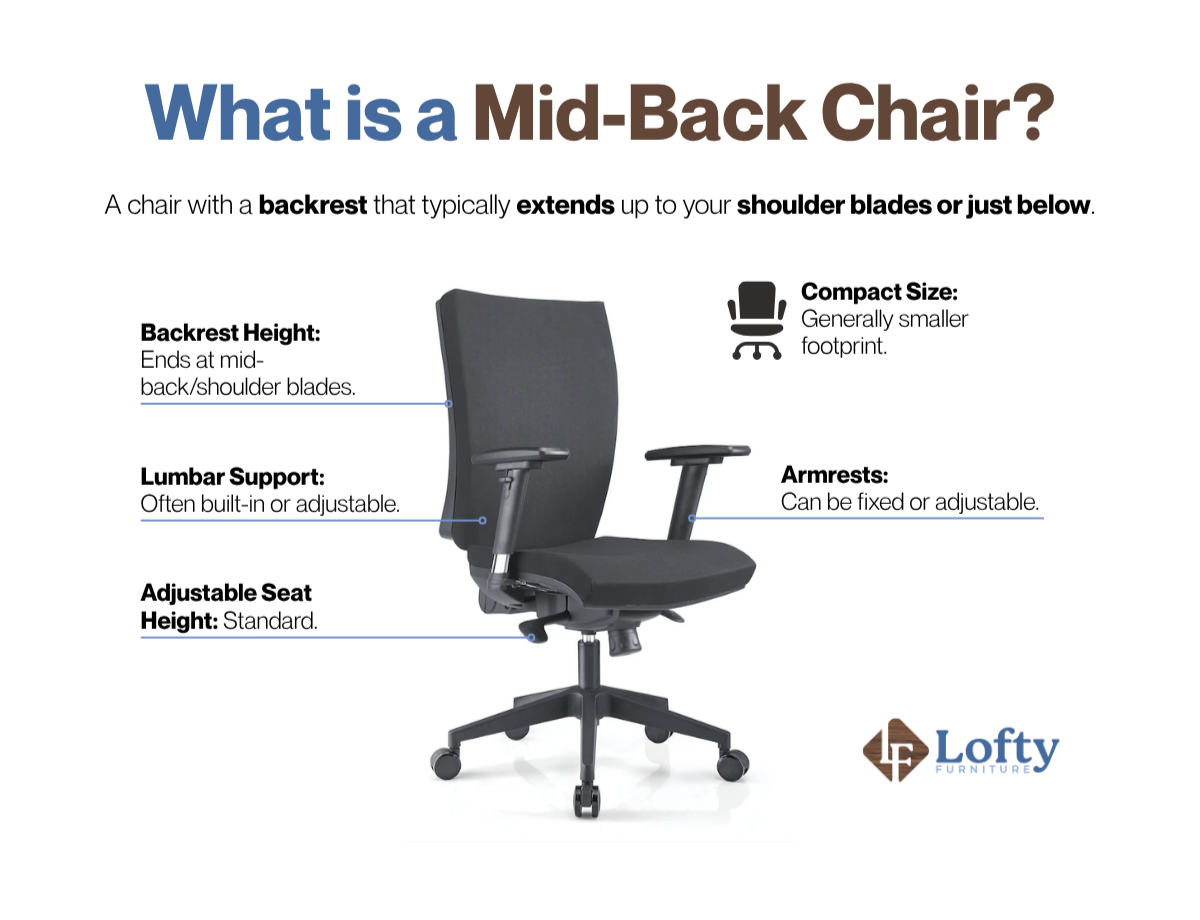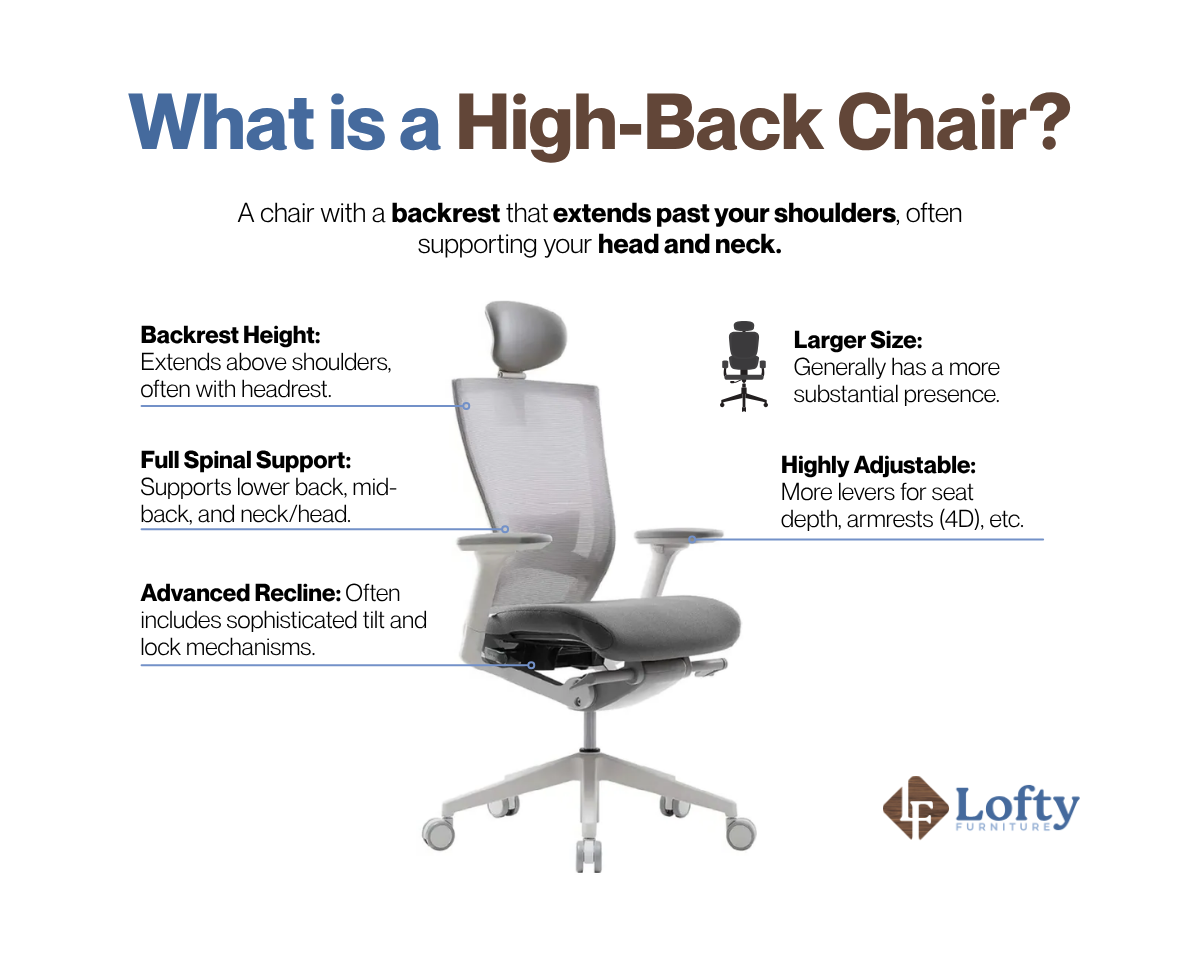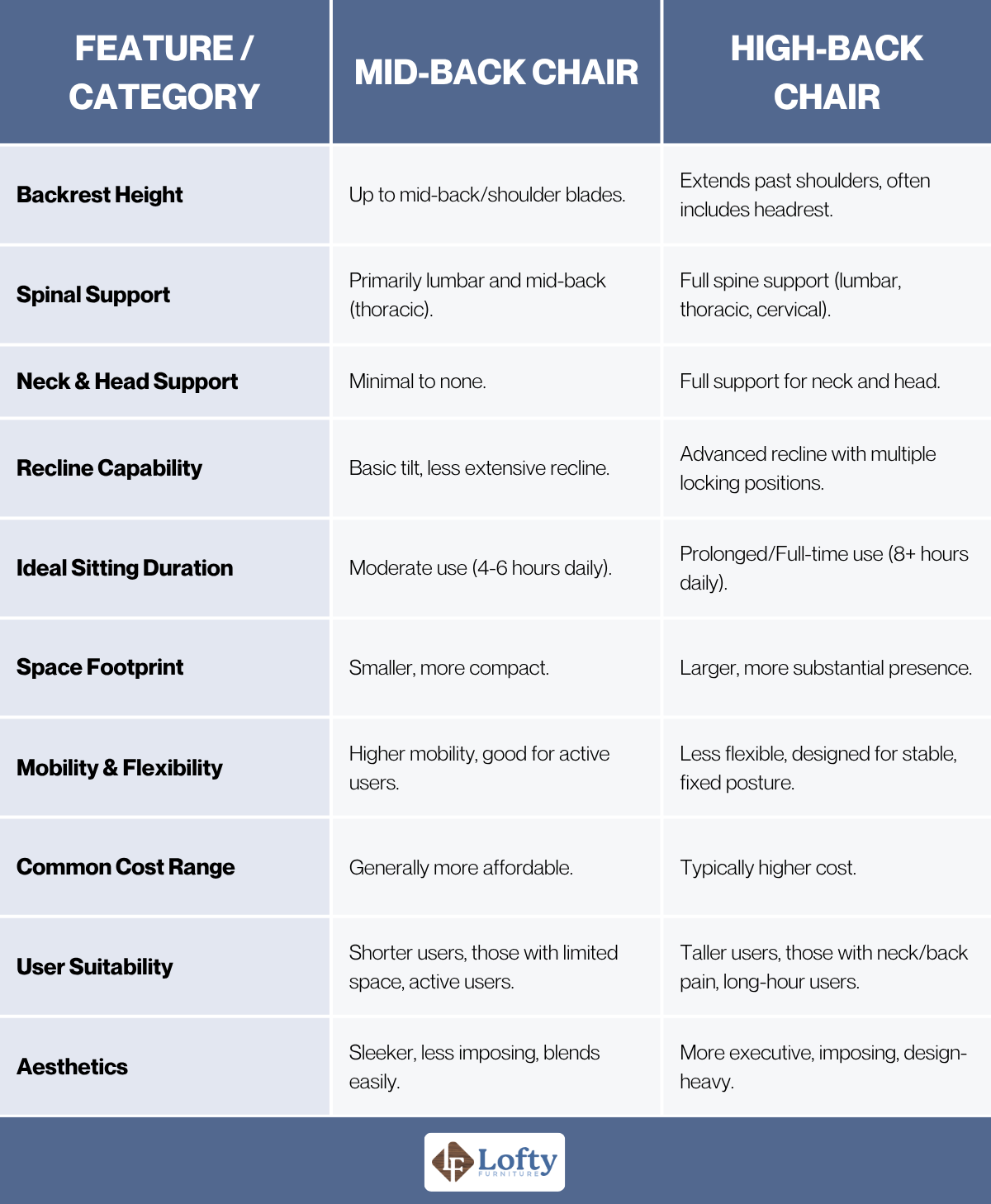Choosing the right office chair for your home setup is more than just about style; it’s about how it supports your body and how it fits into your work routine. With hours spent sitting at your desk, the right chair can make a huge difference in your comfort and productivity. But when it comes to picking between a mid-back and a high-back chair, it’s not always clear which one is the better fit for you.
Key Takeaways:
- Mid back chairs are best for shorter work sessions, smaller spaces, and users who prefer an upright posture without needing neck support.
- High back chairs offer full upper-body support, making them ideal for long hours, deeper recline, and relieving neck or shoulder strain.
- Choose based on your body type, workspace size, and any specific comfort or health needs.
This guide breaks down what each option brings to the table, helping you make the right call based on how you work, how long you sit, and how your space is set up.
What is a Mid Back Chair?
A mid-back chair is designed to support the natural curve of your spine. This curve typically reaches up to your shoulder blades or just below them. It’s a common choice in both home offices and traditional workspaces, especially for people who spend moderate amounts of time at their desks. Unlike a high-back chair, it doesn’t extend to support the neck or head. As a result, the design makes it feel lighter, less bulky, and easier to fit into smaller spaces. Because of its compact design, a mid-back chair encourages an upright sitting position and gives enough support for everyday tasks.

What is a High Back Chair?
A high back chair offers full upper-body support, extending from the lower back all the way up to the shoulders, neck, and often the head. It’s built for comfort during long work hours, especially if you tend to lean back or need extra support to reduce strain on your upper spine. These chairs are often associated with executive setups, but in a home office, they serve a very functional purpose too. What sets high back chairs apart is their focus on posture and fatigue reduction. The added height helps distribute your body weight more evenly, which can ease tension across the shoulders and prevent neck stiffness.

Key Differences: Mid Back vs. High Back Chairs
A high back chair offers full-body support, including your neck and head, making it ideal for long hours of sitting or for people who need extra upper back and neck support. In contrast, a mid-back chair focuses on the lower and middle back. It provides a more compact option that fits shorter work sessions or those who prefer greater flexibility and movement.
To provide a clearer picture, here’s a direct comparison of the fundamental attributes that set mid-back and high-back chairs apart:

Ergonomics and User Comfort Over Time
When it comes to long-term comfort, high back chairs generally have the edge. The added support for the upper back, neck, and head can reduce fatigue and improve posture during extended work sessions. Mid back chairs still provide solid lumbar support, but may fall short for those who lean back often or have chronic neck or shoulder tension.
As Dan Mogo, owner of JD Buys Homes, who helps and works with homeowners, notes:
“The most important thing is your work posture and body mechanics. If you lean forward when writing or sketching, a mid-back chair will likely feel less confining. However, if you do a frightful amount of typing and sit up straight for hours at a time, then you’ll want a high-back chair to give structural support for your back.”
Productivity and Work Habits
Your work style plays a big role in which chair works best for you. If your day involves deep focus, long meetings, or tasks that require extended sitting, a high-back chair helps maintain comfort and prevent distractions from physical discomfort. However, if you move frequently, take standing breaks, or switch tasks often, a mid-back chair’s lighter profile can feel more flexible and less restrictive. Dan advises:
“Mid-back chairs suit individuals who prefer shoulder mobility… High-back chairs offer overall spinal support… promoting proper alignment throughout extended work periods.”
Design, Space, and Aesthetics
High back chairs tend to dominate a room visually. They’re larger, more noticeable, and often styled to make a statement. That can work well in a spacious home office but might feel overwhelming in tighter setups. Mid back chairs, by contrast, are more space-conscious. They blend in easily and create a more open, minimalist look. The mid back option is often easier to style around without sacrificing essential support.
Critical Factors for Choosing Your Home Office Chair
Not all chairs are equal, and not all bodies or workspaces need the same kind of support. Here are the key factors to weigh before making a decision.
Your Body Type and Size
Taller individuals often feel under supported in mid-back chairs, especially in the shoulders and upper spine. In contrast, shorter users might find high back chairs too large or awkward if the headrest sits too high or pushes them forward. The best option is one that lines up with your back’s natural curves and allows you to sit without straining or slouching.
Workspace Size and Duration of Daily Use
Mid back chairs have a smaller footprint and are easier to tuck away or move around. But if you’re putting in 6 to 8 hours (or more) at your desk daily, ergonomic support becomes a higher priority, even if it means making room for a high-back chair. The longer you sit, the more that full-body support pays off in comfort and focus.
Specific Health Concerns
Chronic back pain, shoulder tension, or neck stiffness should factor heavily into your choice. High back chairs are generally better suited for people managing upper spine or neck issues, especially when paired with adjustable features. On the other hand, if your discomfort is mainly in the lower back or hips, a well-designed mid back chair with good lumbar support might be all you need.
Who Should Choose a Mid-Back Chair?
A mid-back chair is a solid fit for people who work shorter hours at a desk, take frequent breaks, or prefer a more active sitting posture. It’s also ideal if your workspace is part of a shared area like a bedroom or living room, where space and visual clutter are concerned. Remote workers who don’t need head or neck support, especially those who sit upright most of the time, will likely find a mid-back chair comfortable and practical without the bulk of a full-sized alternative. As Dr. Hiral Jain Surana (PT), Co-Founder of TRIO Physiotherapy, explains:
“As a Physiotherapist, I often tell my work-from-home clients that picking between a mid-back and high-back chair isn’t just about style – it’s about how your body feels after a long day. Mid-back chairs can work well if you sit actively, take breaks often, and don’t need neck support.”
Who Should Choose a High Back Chair?
If your job demands long, uninterrupted periods of sitting like programming, writing, editing, or virtual meetings that run back-to-back, a high back chair is the smarter choice. It’s especially helpful for those who deal with upper back or neck discomfort, as the extra support can significantly reduce strain throughout the day. High back chairs are also great if you lean back often to think, rest, or read, and they make sense in dedicated home offices where space and style can accommodate a larger chair. Dr. Hiral adds:
“High-back chairs, on the other hand, offer full support up to the neck and shoulders. If you’re spending 6-8 hours a day at your desk, that upper-back and cervical support can really reduce tension and fatigue. I’ve had clients tell me their daily headaches eased up just from switching to a high-back chair with a headrest.”
Upgrade your workspace today! Explore our selection of ergonomic chairs designed for ultimate comfort and support, whether you prefer a mid-back or high-back style.
Final Verdict: Which Chair Is Right for You?
The right chair really depends on how you work, how long you sit, and what kind of support your body needs. If you’re after full-body comfort for long hours and have the space for it, a high-back chair is likely the better fit. But if you prefer something more compact, flexible, and upright, a mid-back chair might hit the sweet spot. Neither one is “better” across the board. It’s about aligning the chair to your body, your space, and your workday rhythm.
Frequently Asked Questions
Is a high-back chair better for posture?
Yes, especially for those who sit for long hours. High back chairs support the entire spine, shoulders, and neck, helping maintain a neutral posture and reducing slouching. But keep in mind that posture also depends on how you sit and whether your chair is adjusted correctly.
Can a mid-back chair provide enough support for remote work?
If your work sessions are moderate in length and you don’t experience upper back or neck issues. A good mid-back chair with proper lumbar support can comfortably carry you through several productive hours without issue.
Do I need a headrest in my office chair?
Not everyone does. A headrest can be helpful if you lean back often or experience neck strain. However, if you sit upright and don’t rely on back support for extended periods; a headrest is more of a comfort add-on than a requirement.
How do I measure myself for the right chair back height?
Sit upright and measure from your seat to the top of your shoulders or the base of your head, depending on whether you want shoulder-only or full head support. Mid back chairs should support up to the shoulder blades, while high back chairs should extend beyond the shoulders for full upper-body coverage.
